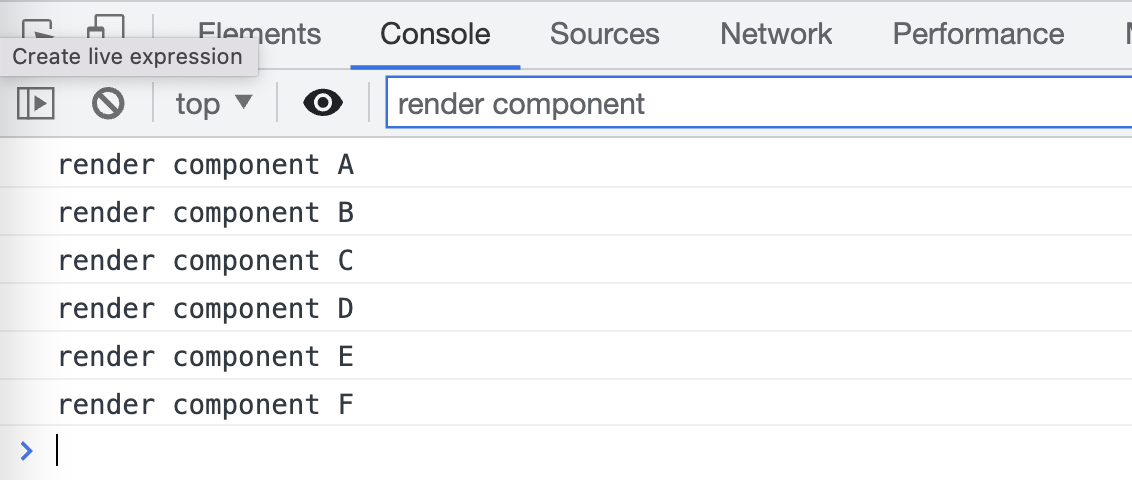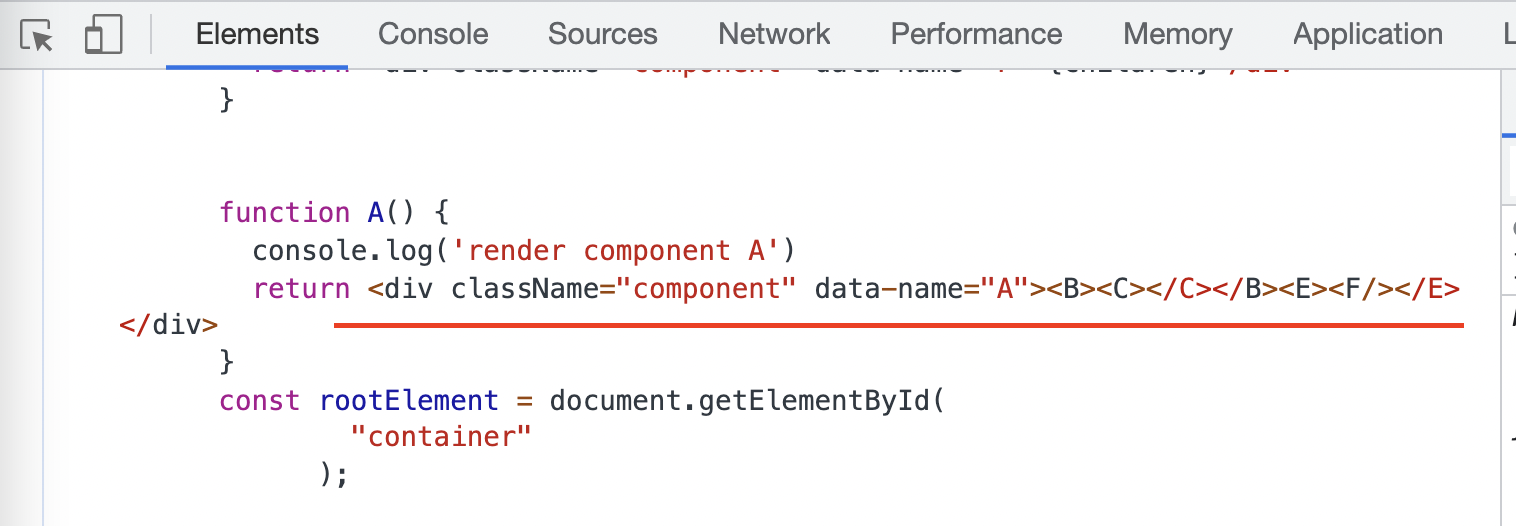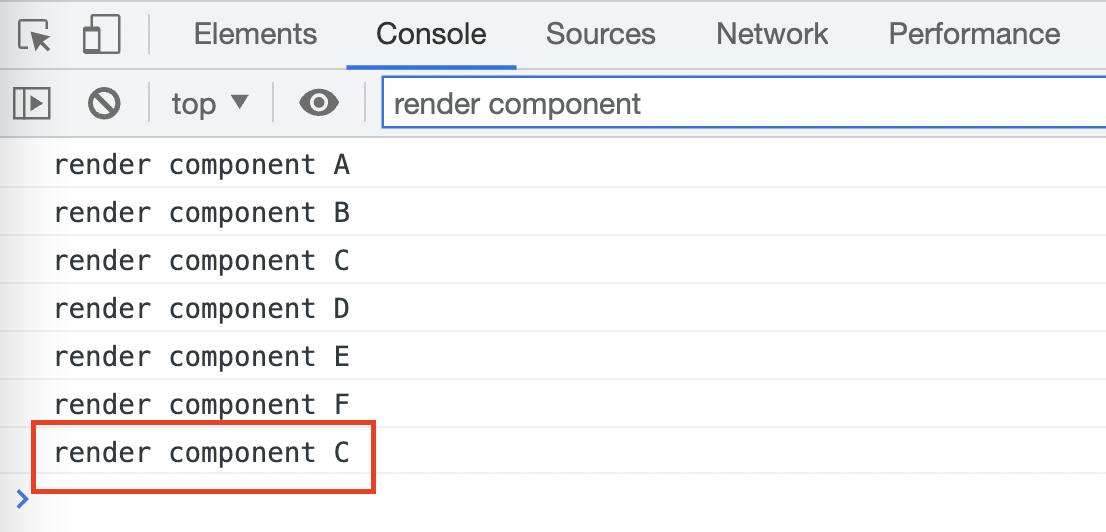How does React bailout work in reconciliation?
Demo
Open this demo link, there is the famous button which increments when clicked.
Open the dev console you can filter the logs of render component.

You can see the React code in the Elements tab.

The structure is simple:
Now click the button, as we talked before in our video series, setState actually triggers reconciliation from the root, theoretically all the components should be rerendered, but we only see rerender for C and D

lanes & childlanes
Clear the filter in dev console, you should be able to see the logs I’ve already put there, you can click them to see the source code.

We can see a bunch of setting of lanes and childLanes after button is clicked.
In dispatchSetState() which is the setCount() in our react code, we can find the call of scheduleUpdateOnFiber() (source)
js
js
Yeah, we’ve already found it, markUpdateLaneFromFiberToRoot(). (source)
it does two things
- set
lanesof target fiber, to mark itself has work to do - set
childLanesof all ancestor fibers, to mark that its children have work to do.
Now if we are to draw a fiber graph after clicking the button, and including lanes and childLanes, it would be like this (first number is childLanes)

performUnitOfWork()
scheduleUpdateOnFiber() would schedule a reconciliation callback through ensureRootIsScheduled(), which simply speaking, keep running performUnitOfWork() on all the fiber nodes. (source)
js
js
shouldYield() is another topic about expiration which we will cover in the future. For now let’s just focus on performUnitOfWork().
In it , beginWork() has the real logic of checking if we can stop earlier(bailout) or not. (source)
just from the code we can roughly know what is being done here
- if props and context changes, then we should continue
didReceiveUpdate = true - if not, then we check if there is scheduled updates by
checkScheduledUpdateOrContext() - if no scheduled updates, then we try to bailout by
attemptEarlyBailoutIfNoScheduledUpdate - when update is needed,
updateFunctionComponent()is called for functional components
One thing to notice is that the return value of beginWork() decides the next step of performUnitOfWork(). If it is null, meaning we should stop and finish. (source)
checkScheduledUpdateOrContext() is simple, just checks lanes
js
js
in checkScheduledUpdateOrContext() , bailoutOnAlreadyFinishedWork() is called, and childLanes is checked. (source)
So things are clear now.
- basically React goes to every fiber, from root to all the fibers
- but if some fibers has no props changes, no context change, and both
lanesandchildLanesas 0, it bails out
Go back to our dev console, you can understand why A B E F are not rerendered.
A and B: try to bailout in updateFunctionComponent() (source) since no update found, so no rerender. But their children C has work to do, so continue to C
E: bailout at beginWork()
F: since bailout at E, F is not checked at all.
Wait, why D is rerenderd?
Good question.
This is because <D/> is in C which means when C is rerendered, it creates a new element of D, and leads to props change.
Let’s explain it in more details.
in beginWork() if some work on C is found, updateFunctionComponent() is triggered since C is functional component.
To update a functional component, first we execute (rerender) it to get the new element and then reconcileChilren. (source)
js
js
In our case, children is an array of button and D, finally it goes to reconcileChildrenArray(). (source)
In it, we can see the code of updating the new fiber array.
js
js
Drill down to updateSlot() then we go to updateElement() (source)
In updateElement() , below function is used to create(or reuse) a fiber
js
js
Go to createWorkInProgress, we see the code where pendingProps is used.
js
js
Yep, <D/> is created every time when C() is executed, pendingProps would be different every time, though equal in value but not the same object.
So in beginWork(), it is treated as an update since oldProps is not newProps.
js
js
Move children to props leads to bailout
From the above analysis, we also understand why moving <D/> to children in props of C would leads to bailout on D.
Here is code change.
diff
diff
Go to our second demo link, again open the console and click the button, we can see D is not rerendered this time.

Why? Simple.
Because when C() is executed, children is passed in as an argument, which means in createWorkInProgress(), pendingProps is exactly the same, thus bailout happens.

Want to know more about how React works internally?
Check out my series - React Internals Deep Dive!
